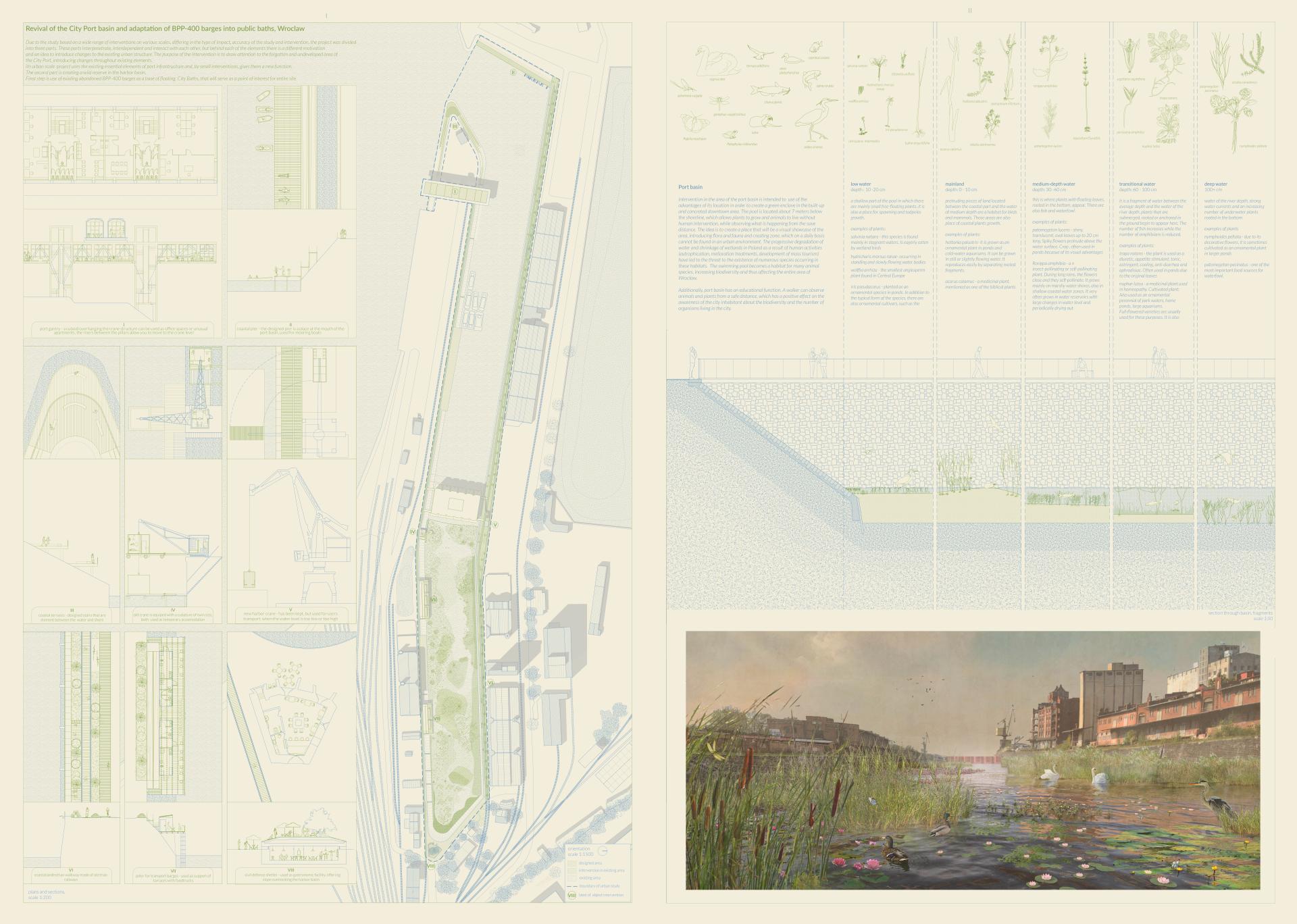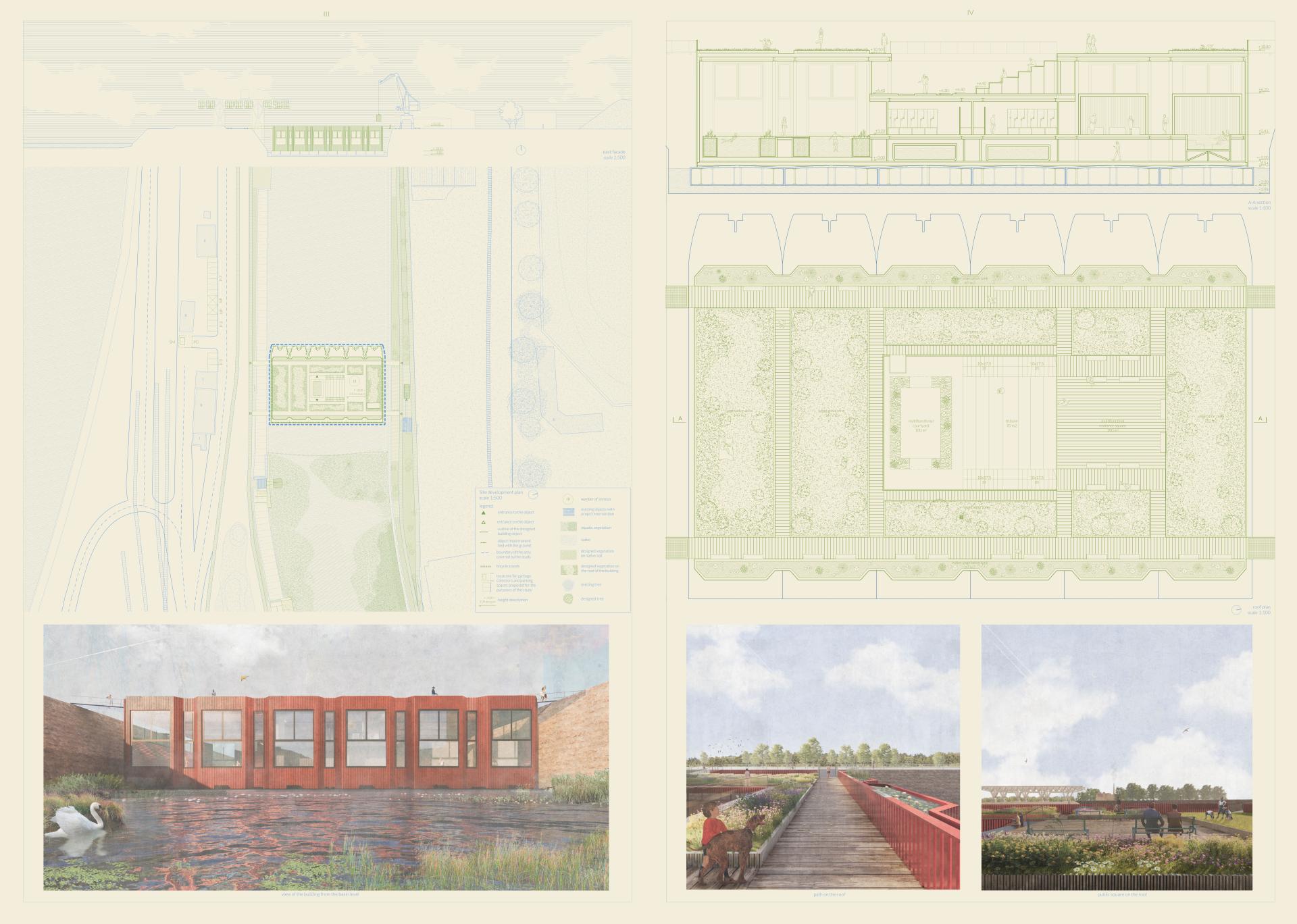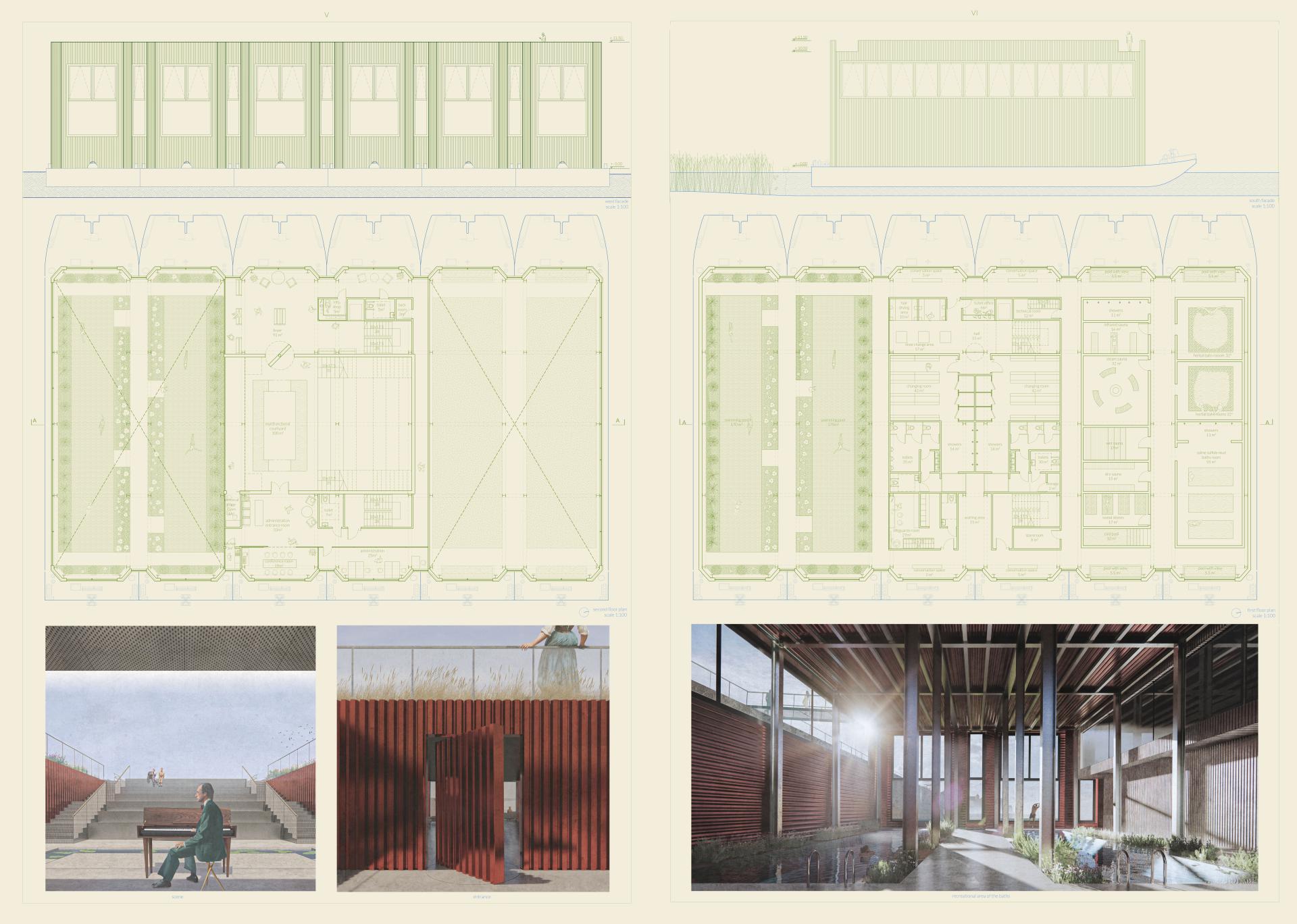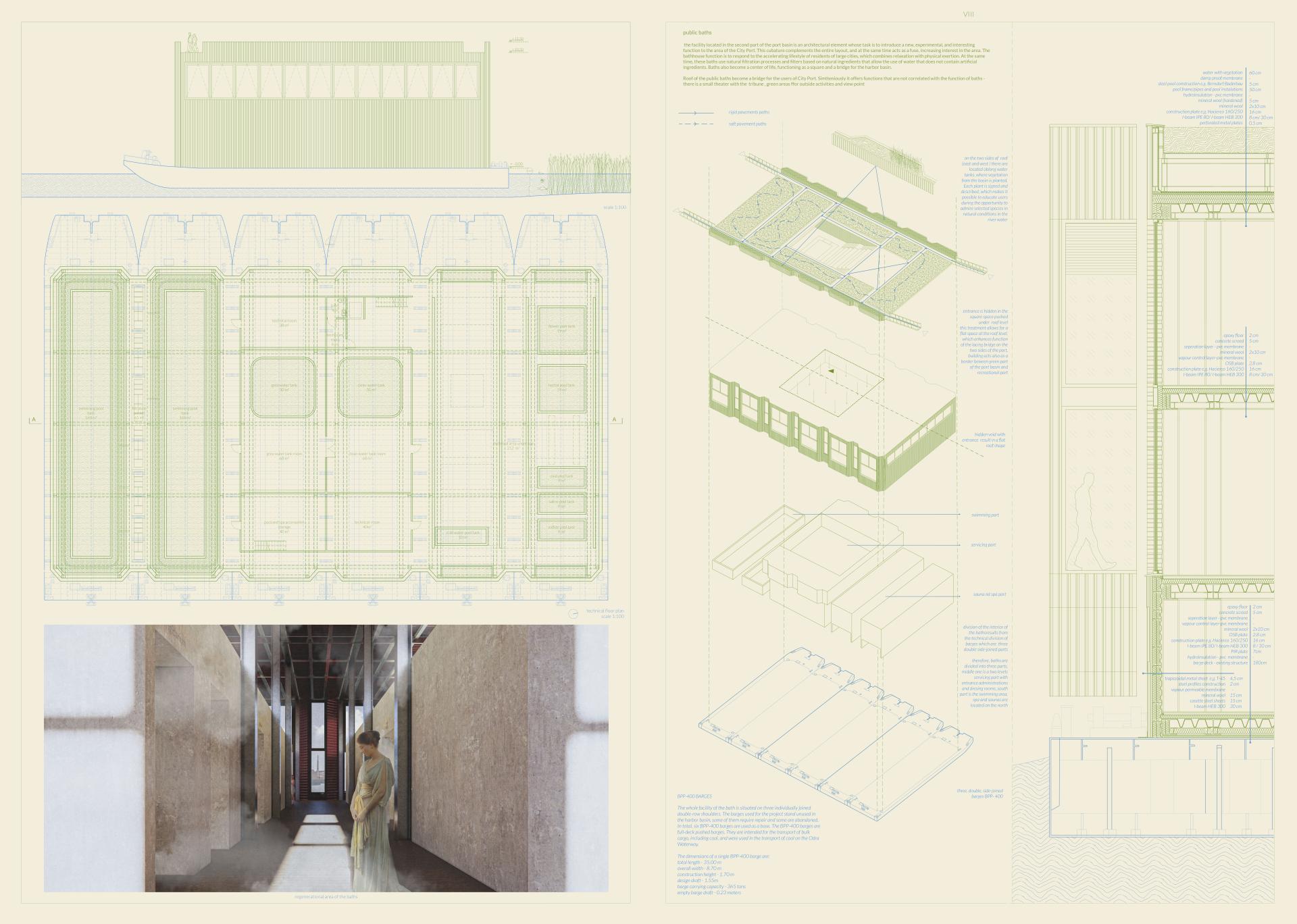Revival of the City Port
Basic information
Project Title
Full project title
Category
Project Description
The subject of intervention is the abandoned hundred-year-old City Port in Wroclaw. More precisely, a part of it - the port basin - which is an element initiating the renewal process of the entire area. Proposed idea brings back to life valuable fragments of urban tissue to use the advantages of its location in order to create a green enclave in the built-up and concreted downtown area, and therefore develop urban fabric in a thoughtful and far-sighted way.
Geographical Scope
Project Region
Urban or rural issues
Physical or other transformations
EU Programme or fund
Which funds
Description of the project
Summary
The subject of intervention is the abandoned hundred-year-old City Port in Wroclaw. More precisely, a part of it - the port basin - which is an element initiating the renewal process of the entire area. The port basin is connected with the Odra River and located in the central part of the City Port. The proposed idea combines three features: bringing back to life valuable fragments of urban tissue, the application of areas promoting urban biodiversity and the introduction of an object with an unusual function that uses the possibilities and highlights the character of the place. The project on an urban scale uses the existing essential elements of the port infrastructure and gives them a new function through minor intervention. The second intervention is to create a wild, green enclave in the port basin. Intervention in the area of the port basin is intended to use of the advantages of its location in order to create a green enclave in the built-up and concreted downtown area. The pool is located about 7 meters below the shoreline, which allows plants to grow and animals to live without human intervention, while observing what is happening from the save distance. The last step is to use the existing abandoned BPP-400 barges as a base for floating city baths, which will be a point of interest for the entire location .The is an architectural element whose task is to introduce an interesting function, increasing interest in the area. The bathhouse function is to respond to the accelerating lifestyle of residents of large cities, which combines relaxation with physical exertion. The roof of the public baths becomes a bridge for the users of the City Port, it also offers functions that are not correlated with the function of the baths - there is a small theater with a stand, green areas for outdoor activities and a viewpoint enriched with water tanks illustrating the diversity of plants growing in the port basin.
Key objectives for sustainability
In the urban scale, the main aim was to show possibility of creation of conscious, eco friendly city, where people live close to nature, even though they live in the city center. Showing and proving the possibility of fitting natural ecosystem in the industrial plot was the main task of the urban scale proposition. Creation city that is developing in the thoughtful far sighted and pro- ecological way should be one of the main urban challenges for XXI century.
The main objective of the project is to reuse what is already existing. In an urban scale, development of the project is based on reuse of existing port infrastructure, through giving it a new function (e.g. change of railway tracks into pedestrian and bicycle routes, use of historic cranes as hostels). In terms of intervention in port basin, sustainability is made through using existing conditions in order to create wild green infrastructure that naturally filtrates basin water, reduces Co2 and is a habitat for animals. The public baths reuse BPP -400 barges that are stocked in the city port. The passing times of the river transport contributed to the lack of utility of those barges. Building is designed as a self-sufficient, green roof with solar panels, natural filtration of the water in the pools and natural ventilation of the area of baths and saunas. To make baths as natural an sustainable as possible water is naturally filtrated by systems of filtration, which do not require the use of chemicals.
Whole project is trying to recreate part of old industrial city port into the eco-friendly, green and sustainable area, that become an impact for the further development of rest of the port.
Key objectives for aesthetics and quality
The shape of the building resembles the loading area of the BPP 400 barges, which results in the appearance of bay windows on the front elevations, which bring more light into the room, at the same time sculpting the metal body. The roof of the structure was flattened and leveled to the height of the river bank, with the maximum draft of the barge and the average height of the water level (1.80 meters). A rectangular opening has been cut in the flat surface of the roof, hiding the entrance to the bathhouse building, creating an additional, intimate stage space
City baths building is designed to contribute to the industrial character of the area, built up on the old barges, covered with trapezoidal metal sheets. Entrance to the building is hidden under the surface of roof, which encourage users to explore the area of a public space on the top of the baths. The entrance to the building takes place through a small stage and glass walls overlooking the swimming pool part, the entire building is maintained in a harsh industrial atmosphere, softened by greenery appearing at every step. Designed on the grid of HEB I beams functional programm divides area into three parts ,middle one is a two levels servicing part with entrance administrations and dresing rooms, south part is the swimming area, spa and saunas are located on the north. Simple division of building makes it easy to understand and use.
Key objectives for inclusion
Project is designed in a way, that allows to relocate building if needed. Built up on three, double side-joined BPP-400 barges, functional program is also divided in the way, that allows to divide whole building into three parts and relocate it. Building itself, although located in the difficult conditions of XIX century port is accessible for disabled people. Creation on the roof public space, with the public plaza, green areas for outside activities and small theater aim to enhance social connections and support the creation of a strong community.
Results in relation to category
Intervention in the area of the port basin is intended to use of the advantages of its location in order to create a green enclave in the built-up and concreted downtown area. The idea is to create a place that will be a visual showcase of the area, introducing flora and fauna and creating zone, which on a daily basis cannot be found in an urban environment. The progressive degradation of water and shrinkage of wetlands in Poland as a result of human activities (eutrophication, melioration treatments, development of mass tourism) have led to the threat to the existence of numerous species occurring in these habitats.The swimming pool becomes a habitat for many animal species, increasing biodiversity and thus affecting the entire area of Wroclaw .Additionally, the swimming pool has an educational function. A walker can observe animals and plants from a safe distance, which has a positive effect on the awareness of the city inhabitant about the biodiversity and the number of organisms living in the city.
To make the baths as natural as possible, affecting both the soul and body, the water cleaning technology was used in the pool. Due to the need to use the swimming pool inside and intended for a large number of people, the only possible solution was an eco-pool.The final solution was to create two 6x28 meter pools with a regeneration area surrounding each pool, with a total of six HydroGravity gravity filters. The research from TU Delf about natural indoor pools showed “that biological water purifcation is possible in indoor swimming pools and that chlorine is not necessary for public indoor pools. In this research special attention is paid for the removal of phosphorus and E.coli for the design. For the design of the swimming pools can be concluded that special attention should be paid for the indoor climate, in terms of temperature and lighting and that this should be in harmony with the chosen plants.
How Citizens benefit
Functions designed in the port area were the result of the study for the “Nadodrze Masterplan area, analysis" which is 133 pages document included the results of urban analyzes and social consultations for the area.
Physical or other transformations
Innovative character
The theme of a green, overgrown and full of life pool is an attempt to break with the popular and, unfortunately most often seen in development housing estates, view of crystal-clear water reservoirs filled with chemicals, making people aware of this image of a luxurious place for water. As part of the project, the author tries to convince that a living water reservoir can bring many visual, educational and, above all, natural benefits. Observing the flowering of various plants depending on the season, the behavior of wild animals and the diversity of birds, as well as the feeling of belonging to the natural world is an extraordinary experience, especially in urban conditions.
Second of all, the technology of public pools and baths is nowadays are based on chemicals that get rid of bacteria from the water, replacement of artificial chemicals by plants which are closer to people, healthier for their skin and soothing mentally can be a big step in the development of pool technologies.
Learning transferred to other parties
Transferring project results could help with understanding importance of reusing urban fiber instead of building new districts in the modern cities. Approach to the wild nature in the cities could help recreating self conscious




